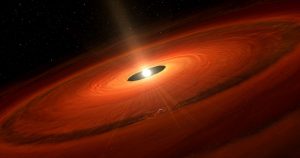
Astronomers Spotted Icy Giant Planet Growing Around Nearby Star
Scientists have found signs of a baby planet thought to be an icy giant – similar to Uranus and Neptune – growing around a nearby star, a discovery that may help better understand the origins of various types of planets.
Astronomers spotted the planet around TW Hydrae, a nearby young star which is 176 light-years from Earth, using the Atacama Large Millimetre/submillimetre Array (ALMA) in Chile.
While a number of new planets have been found in the past two decades, it is still unclear how the icy giant planets form.
The scientists hope that the finding could be another step towards understanding the origins of various types of planet.
Astronomers from Ibaraki University in Japan have observed the growing planet around TW Hydrae – a nearby young star. This star, estimated to be 10 million years old, is one of the closest young stars to Earth.
TW Hydrae is one of the most favourable targets for investigating planet formation.
Past observations have shown that TW Hydrae is surrounded by a disk made of tiny dust particles. This disk is the site of planet formation.
Recent Atacama Large Millimeter/submillimeter Array (ALMA) observations revealed multiple gaps in the disk. Some theoretical studies suggest that the gaps are evidence of planet formation.
The team observed the disk around TW Hydrae with ALMA in two radio frequencies. Since the ratio of the radio intensities in different frequencies depends on the size of the dust grains, researchers can estimate the size of dust grains.
The ratio indicates that smaller, micrometer-sized, dust particles dominate and larger dust particles are absent in the most prominent gap with a radius of 22 astronomical units.
Theoretical studies have predicted that a gap in the disk is created by a massive planet, and that gravitational interaction and friction between gas and dust particles push the larger dust out from the gap, while the smaller particles remain in the gap.
The current observation results match these theoretical predictions.
Researchers believe that the planet is probably a little more massive than Neptune.